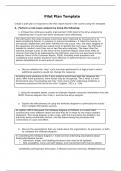Pilot Plan Template
Create a pilot plan in response to the VOC report found in the course using this template.
A. Perform a root-cause analysis by doing the following:
1. Critique the continuous quality improvement (CQI) team's five whys analysis by
explaining how it could have been conducted more effectively.
The CQI team's five whys analysis could have been improved by focusing on or at
least considering failures in systemic or process breakdown. It relied too heavily on
one specific department and didn't identify the root cause. Also, the team stopped at
five questions and should have asked more to identify the root cause. The CQI team
needed to conduct more than one or two five whys analyses. The lower than the
national average scores on the Voice of the Customer Report show three areas of
concern that need to be addressed by the CQI team, and only one was found in this
analysis (Voice of the Customer Report, 2024). Including more questions and
completing more studies would be more effective in determining the root cause of
patient dissatisfaction in each area of concern.
a. Discuss whether the “why” cycle has been performed to a logical end in which
additional questions would not change the response.
Including more questions in this 5 why analysis would have kept the response the
same. With more questions, more issues may be recognized. The 5 whys is a one-
dimensional way of evaluating and may "miss many of the underlying problems in
numerous processes that led to the error" (Lighter, 2013, p. 114).
2. Using the template below, create an Ishikawa diagram using the information from the
SIPOC Process diagram from Task 1, and the five whys analysis.
a. Explain the effectiveness of using the Ishikawa diagram to synthesize the results
from multiple information sources.
As Lighter (2013) discussed, the Ishikawa diagram or fishbone is a visual chart
summarizing many different items and how they fit or relate to one major problem
statement. This visual diagram is like a tree, with the trunk being the problem, the
branches being contributory factors, and the leaves being the processes and
connections or cause and effect.
b. Discuss the assumptions that you made about the organization, its processes, or both
to complete the Ishikawa diagram.
In completing the Ishikawa diagram, I made several underlying assumptions about
Shelbyville Medical Center.
Admission, triage, and bedding processes may need to be updated.
Bed availability, nurse call light fatigue, and overworked staff may be adding
Confidential and Proprietary Information. © Western Governors University. All Rights Reserved.
, to the reasons patients are not receiving help as promptly as they would like.
Physician communication standards may need evaluation.
Discharge teaching and process may need to be examined.
Staffing shortage may be contributing to decreased patient satisfaction
The onboarding process of new hires and agency nursing needs to be
evaluated.
B. Using the information from the root-cause analysis in part A (e.g., the five
whys analysis and the Ishikawa diagram) and the previously completed project
charter from Task 1, do the following:
1. Identify three opportunities for improvement.
Timely care for patients receiving assistance at Shelbyville Medical Center.
1.
Patients will receive improved communication from physicians, providers, and staff
2. during their stay.
Patients receive an improved understanding of their diagnosis, care process, and
3. discharge instructions, including treatment following discharge.
2. Recommend one improvement strategy for each of the three opportunities identified
in part B1.
Opportunit Improvement Strategy
y
#1 Improve triage, bedding, admission, call light, and discharge processes.
#2 Work with the Chief Medical Officer, ED Physician Chair, and Medical Staff
Coordinator to provide in-service and training on communication skills that
include active listening, clear and straightforward language, and
opportunities for physicians to include their patients in decision-making
about their care plan, treatment options, and potential risks.
#3 Work with Education, IT, ED Physician Chair, and ED Director to evaluate,
update, reword, and revamp discharge teaching material.
3. Create an improved process flowchart that represents what an ideal process might
look like considering the current Shelbyville Medical Center model from Task 1.
Confidential and Proprietary Information. © Western Governors University. All Rights Reserved.




